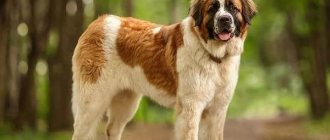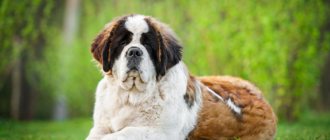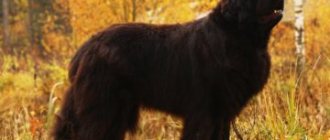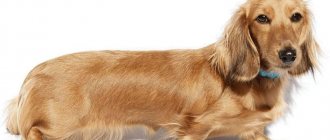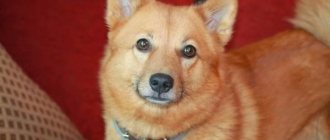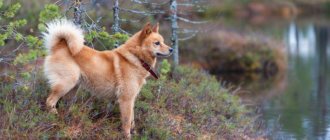Breed characteristics
| Short description | |
| Origin: | Switzerland |
| Conditions of detention: | Preferably a country house with a large plot |
| Purpose: | Rescuer; companion |
| Color: | White with red or red with white |
| Wool length: | Shorthair: 4-5 cm; long-haired 6-8 cm |
| Adult dog size: | The height of males is at least 70 cm, weight from 60 kg; bitches height from 65 cm, weight from 50 kg |
| Average life expectancy: | 9 – 11 years |
| Walk: | Daily walking required |
| Physical activity needs: | Average load requirements, walks 2 – 3 hours a day |
| Classification of the International Canine Federation (FCF): | Group 2 Pinschers and Schnauzers, Molossians, Mountain Dogs and Swiss Cattle Dogs; section 2 Molossians |
| Puppy price: | The average cost is 10,000 – 20,000 rubles, a show class puppy costs up to 55,000 rubles |
Health
Saint Bernard is not one of the most painful dogs. After all, his distant ancestors were adapted to survive in the harshest conditions. However, this does not mean that they do not get sick. Their weakest point is the musculoskeletal system. Considerable weight does not have the best effect on joints.
Dysplasia, dislocations and osteosarcoma are some of the most common reasons for contacting veterinarians among owners of this breed.
In addition, these animals are predisposed to such ophthalmological problems as entropion, cataracts and third eyelid adenoma, also called “cherry eye”.
Alas and ah, even in the most excellent home conditions with sufficient physical activity and a balanced diet, St. Bernards live very little - rarely do any of the giants live to be 10 years old, and this is perhaps the main drawback of the breed, according to the reviews of the owners themselves, who were forced to part with your favorites.
pixabay.com/Alexas_Fotos
History of the origin of the species
The first mentions of St. Bernards came from the beginning of the 17th century. Alpine monks used large guard dogs to search for and rescue travelers lost in snowstorms from the snow. The ancestors of the Saint Bernard are considered to be mastiff-like and mastiff-like ancient dogs that followed the Roman legions as they passed north from the Alps.
It was the monks of the Augustinian monastery of St. Bernard who were the founders of the breed. Already since 1800, they were engaged in almost purebred breeding.
The most famous specimen was the St. Bernard, nicknamed Barry, who saved more than 40 people during his life. From then to this day, in every litter born at the monastery, there is a puppy named Barry.
Individuals from the 17th and 18th centuries were much smaller and lighter than the modern St. Bernard. The size of the breed was increased by crossing with Newfoundlands. From them came the long-haired representatives of the breed. Until this moment, there were only shorthaired ones.
In 1865, the breed received the official name - St. Bernard. And in 1884, the first official representative, nicknamed Leon, was entered into the stud book. Along with him there are 28 more individuals. On June 2, 1887, the first mandatory breed standard was drawn up. The last changes to the species specimen were made in 2004.
Reviews
Julia: “Saint Bernard has been living with us for 4 years. This is the most devoted, great friend. He understands everything perfectly, rarely barks and does not bother his neighbors. The only negative is drool and fur. If you comb it regularly, and during the shedding period 2-3 times a day, then the problem is not so much of a concern.”
Ivan: “I love dogs of this breed. The first lived for 8 years, the second is now 10, the third is still a puppy. Their virtues captivated me: they love children, they are loyal, balanced, they do not spoil furniture.”
Oleg: “Our friend St. Bernard looks like a cute, shaggy monster. He is intimidating with just his appearance, protects the house, and does not cause inconvenience with constant barking, like the dogs around the neighborhood. The only negative is the drool that flies onto the floor, sofa, carpet.”
Distinctive features
The main distinguishing characteristics of St. Bernards are:
- General form. The dog is huge, strong, resilient and heavy. With the same huge head, proportional to the body.
- Head. Large, like the body, heavy, damp. With a wide protruding forehead, strongly protruding cheekbones. The transition from the forehead to the nose is significantly pronounced.
- Lips. Thick, hanging, loose. The upper jowls cover the lower jaw. Pigmented black, pink markings possible.
- Muzzle. Wide, short, smooth. Does not expand from nose to forehead. The bridge of the nose is slightly turned up or straight. The nose is large, with wide nostrils, and pigmented black. Scissor or pincer bite. Teeth set – 42 pieces.
- Neck. Powerful, muscular, shortened. It has a pronounced, massive dewlap, but without going overboard. The transition from neck to back is significantly pronounced.
- Frame. The shoulder blades are wide, muscular, and set obliquely. The chest is wide, not drooping, with prominent ribs. The back is wide, powerful, without sagging. The loin is voluminous, the croup is very well developed. Powerful, strong, strong thighs. The stomach is slightly tucked in.
- Tail. The base of the tail is at the level of the waist - set high. Heavy, long, wider at the base than at the end. Lowered, except in a state of excitement.
- Limbs. Well developed, muscular, straight and strong. Strong arched fingers, slightly closed. The paws are large, powerful with well-developed muscles.
- Coat and color. The coat is very thick, medium hard, and fits well to the body. There is a dense undercoat. On the thighs and tail the hairs are longer and thicker, but without dewlap. Red color, spots from reddish-brown to yellow. A white tip of the tail, paws, chest, “collar” or spot on the neck is considered obligatory. A black mask with a white stripe on the forehead is permitted.
Disqualification
- Aggression, cowardice.
- A pronounced overshot or undershot bite.
- Entropy, ectropy.
- Belmo.
- The height at the withers is below the minimum value.
- Any other coat color.
- Completely white or completely red color.
- Clearly demonstrated physical or behavioral abnormalities.
Note : Males must have two normally developed testes that are fully descended into the scrotum.
- Mating of St. Bernards
- St. Bernard's character
- American type St. Bernard
Photo of an adult dog
What to feed
Half of the St. Bernard's diet should be food rich in protein, namely meat.
- For a St. Bernard puppy the norm is 150-200 grams,
- And for an adult, 400-500 daily.
It can be beef, lamb, elk, horse meat, rabbit, etc. Pork is usually not given, because... it may be infected with helminths (worms). You can feed offal: kidneys, lungs, heart, liver, you can offer udders, etc.
Fish is allowed. River fish is doused with boiling water before serving, while sea food is acceptable fresh.
You can also include cereals in your diet: buckwheat, rice, oatmeal. The following are added to porridge: vegetable or butter, vegetables, fruits, herbs and even garlic. Cottage cheese and kefir will be beneficial for the development of the little friend’s support system. Veterinarians recommend giving bone chewing until permanent teeth appear.
The following foods should be excluded from the diet:
- Potato;
- Legumes (peas, lentils, beans, etc.);
- Spicy foods;
- Smoked meats.
Do not give your dog food from your table: what is good for you can be harmful for your dog!
Photos of puppies
Features of character and behavior
Saint Bernards are distinguished by their good-natured disposition, love and tenderness towards children. They are incredibly attached to people and are very bored when alone. Classified as wonderful companions, they are called nanny dogs. Despite its impressive dimensions, it is very neat.
You can safely leave even the smallest children with them, without fear that the dog will accidentally hit and knock down the baby.
There are some somewhat lazy and stubborn individuals, this is due to the mastiff genes infused by the British in the 19th century. But this does not prevent St. Bernards from being the favorites of their family and attracting the attention of others.
You should not expect from this breed the agility and activity of shepherd dogs. Due to their size and weight, these dogs are quite slow. But they will never give up playing outdoors, especially in winter. Thanks to their type of coat, representatives of this breed can easily withstand any weather, but in the south they are still hot, because they are mountain dogs.
Calm, even melancholic dogs, balanced and unperturbed. As a rule, silent. A barking St. Bernard is rather an exception. They rarely make good guard dogs, but with their gigantic size they can definitely scare off a stranger.
Advantages
St. Bernard is one continuous advantage. A giant with a kind heart. There are often cases when representatives of this breed saved the lives of their owners with their unique instincts. Either they anticipated bad weather, or they predicted in advance a jump in blood glucose in diabetics.
You can safely leave your children with this shaggy good fellow. Some even learned to walk by holding onto their pet's fur. These dogs have remarkable patience.
Flaws
The only drawback seems to be some stubbornness of St. Bernards, although you can also come to an agreement with them.
For those who want a guard monster, the St. Bernard is absolutely not suitable. Its direct purpose is to save people, not to attack them. With a complete lack of socialization, you can achieve some bitterness. But this is already a deviation in the psyche, and not the norm.
Price
You can buy a dog in a specialized nursery or from dog breeders. When buying a puppy, you should pay attention to the health and genetics of the parents, the conditions and environmental friendliness of their place of residence, and review the medical history. The price of a St. Bernard varies depending on the region, its terrain and the demand for the breed. The average price for a puppy in a St. Bernard nursery reaches $1,500-2,000.
By purchasing a St. Bernard from a breeder, you can reduce the price a little, but you should carefully study the documents and pedigree of the puppy. The cost of this dog is a life full of impressions and joy for both you and your family.
St. Bernard puppy playing with a cat
Saint Bernard is a guard dog , a good friend, protector and assistant. Purchasing a puppy of this breed will become an event in your life, and the dog will become a member of the family. Discipline, intelligence and self-control are the hallmarks of the Sen's character, which, together with kindness and love, makes the dog ideal for a large family or an elderly couple. There are many stories about the exploits of these dogs, and if you decide to get a St. Bernard, you will get a loyal friend and a good protector.
Care and maintenance
Before you get yourself such a huge thing, you should think 10 times and rationally assess your strengths. A large, strong dog requires adequate space and nutrition.
It is highly undesirable to keep a St. Bernard in an apartment. In addition to drool and fur, it will occupy the entire space of a typical building. And not every resident of the metropolis will be able to walk the streets for 3 hours every day, in any weather. Large breeds need this for proper development of joints and tendons.
Excellent conditions for keeping a St. Bernard are a private house with a large garden. The only thing you need is to think in advance where the dog can hide from the scorching sun and rain. This shaggy good fellow is not afraid of frost and snow.
- Eye care requires careful attention due to slightly drooping lower eyelids . There is a risk that small particles will get there and the mucous membranes may dry out. To avoid possible complications, you should check your eyes every day. If necessary, rinse or instill with a special lotion.
- No special care is required for your ears ; it is enough to clean them once a month with a cotton swab moistened with an ear cleaning solution. Modern pet stores offer them in abundance.
- Nails should be trimmed as needed. If a dog often walks on asphalt roads, then, as a rule, they wear down on the rough surface. Otherwise, you need to buy special pliers and trim the claws yourself. This must be done very carefully, without damaging the living tissue on the inside of the claw. You can consult a veterinarian or groomer on this issue.
- Teeth require even less attention to themselves. During their change, you need to make sure that the dairy ones do not interfere with the indigenous ones. If necessary, go to the clinic and remove the excess ones, otherwise there is a risk of curvature of the molars. After about a year, the formation of tartar may begin, as a rule, this occurs due to poor nutrition. In this case, you need to have laser cleaning done by a veterinarian.
Nutrition
With all the good nature of these dogs, one should not forget that, first of all, they are a predator. Nutrition must be appropriate. Both in puppies and adults.
The diet must include:
- Meat
- By-products
- Eggs (whites)
- Cottage cheese (other fermented milk products)
- Complex carbohydrates (rice, oatmeal)
- Fresh vegetables
- Not very sweet fruits (apples)
Be sure to provide additional calcium, collagen or a complex of vitamins for especially large breeds. This is necessary for the proper development of joints.
There is a large number of ready-made foods, already fully balanced for the needs of a particular breed. They are also acceptable to feed the dog, but vitamins should not be neglected, especially with such a heavy breed as the St. Bernard.
The feeding schedule for a puppy and an adult dog varies greatly.
- A baby from 2 to 4 months should be fed 6 times a day.
- From 4 to 6 months 4 times a day.
- From 6 to 10 – 3 meals a day.
- From 10 months of age, you can switch to the diet of an adult dog - 2 times a day.
It is advisable to give a portion a little smaller in the morning than in the evening, since it is more difficult to move around with a full stomach.
We recommend that you read a detailed article on the topic: “How and what to feed a dog: types and characteristics of nutrition.”
Health
Unfortunately, the St. Bernard is not able to boast of excellent health. Huge body weight cannot but affect the joints and cardiovascular system.
During the development period, you need to carefully monitor the puppy. Too rapid growth in body size and weight can lead to exhaustion of the body, lack of minerals and calcium.
With a lack of calcium, the pasterns may sag under their own weight. When this happens, it is too late to give your puppy mountains of calcium. Thus, it will only get worse, the already separated paws will finally harden.
Recovery therapy should be started immediately. More walking up the stairs, going down the elevator. Walk on uneven surfaces such as gravel, crushed stone. Review your pet's diet; in case of such problems, it is definitely due to a lack of nutrients from the diet.
Vaccinations
Before giving the puppy the first vaccination, it is necessary to do helminth prevention; as a rule, this is done by the breeder.
- At the age of 4 - 6 weeks, the entire litter, together with the mother, is given a deworming drug. Even if the dogs have not been infected, the prophylaxis is repeated after 2 weeks.
- Only after twice the prevention of helminths is the first vaccination given.
- At the age of 6 - 8 weeks , they are given a vaccine against plague, hepatitis and enteritis.
- The next vaccination is given against the same diseases, after 4 weeks , consolidating the effect. By this time, it is already possible to give an injection against rabies, but if the puppy is growing up in “greenhouse” conditions, vaccination against rabies may be delayed for up to 6 months.
The entire period from birth to re-vaccination is subject to strict quarantine. Veterinarians recommend not going outside for another week after the last vaccine.
On the day of helminth prevention, as well as after vaccinations, puppies may be drowsy and lethargic. This is considered normal - the body is reacting to the drugs. Cases of intolerance to modern vaccines are rare.
The last puppy vaccination is given a year, against the above diseases. And every subsequent year they are duplicated along with rabies.
Important article on the topic: “Everything you need to know about dog vaccinations.”
Diseases
Saint Bernard is the hero of the dog world only in appearance; his great height and weight do not add to his health. A mastiff-like face contributes to eye diseases.
The most common diseases of this breed are:
- Dysplasia of the hip (elbow) joint.
- Intervertebral hernia.
- Inversion and inversion of the eyelid.
- Cardimopathy.
- Osteosarcoma.
- Pyoderma.
In addition, under excessive stress, puppies with a large mass are more susceptible to dislocations and ligament tears than others.
Don’t be afraid of such an extensive list; not all St. Bernards will necessarily be sick. With the right approach to breeding and raising a puppy, the chances of getting a strong, healthy pet increase several times.
Walk
Any dog needs a walk, this breed is no exception. Saint Bernards need long, leisurely walks in the fresh air. About 3 – 4 hours a day.
In the summer they quickly get tired, but in the winter they are ready to wander through the snowdrifts for a very long time.
Grooming
The coat of representatives of this breed does not cause much trouble. Even on long-haired individuals, it does not get tangled and does not require haircuts or frequent washing.
All that is needed is thorough weekly brushing with a fine-toothed brush. During the shedding period, it is advisable to comb the coat every day.
You should not wash these dogs too often so as not to disrupt natural heat exchange. Otherwise, they will be even hotter in the summer and colder in the winter.
For washing, it is recommended to use only special zoo shampoos. It is better not to bathe puppies under one year of age at all.
The right diet
Saint Bernards are unpretentious in food, but their diet should be balanced and nutritious. Excess weight has a detrimental effect on the dog's health, and lack of nutrition worsens the condition of the coat and the general condition of the pet.
Important! It is better to give the dog a smaller portion in the morning than in the evening. With a full stomach, it will be difficult for a dog to lead an active life and walk.
The animal's diet should include:
- lean raw meat and offal;
- fish (it is recommended to boil it a little);
- fermented milk products (from 6 months);
- fresh vegetables and unsweetened fruits;
- porridge (rice, millet);
- bones with a high content of cartilage.
The dog also needs to be given vitamins. There are entire complexes of minerals for especially large rocks.
There are ready-made foods tailored to the needs of a specific breed. Saint Bernard is a large dog, so any product designed for large animals is suitable for feeding it. You cannot mix natural food and dry food.
Mating
Such large dogs are bred when they reach the age of two, not earlier. These are quite late dogs, and at one and a half years old they are a playful 70 kilogram puppy.
To avoid health problems, you need to wait until the bones are fully formed. Otherwise, the mother’s sagging back and problems with childbirth cannot be avoided. Difficulties with the health of the offspring cannot be ruled out.
Bitches ovulate approximately 10–14 days after the onset of estrus. During this period, an appointment is made with the male dog. These data are approximate and may vary depending on the characteristics of the organism.
Read a detailed article on the topic: “Everything you need to know about breeding dogs: appropriate age, what to do if it doesn’t work out, rules and tips.”
Today, veterinary clinics can take an analysis to determine whether a female dog is ready for breeding. The male is ready to breed all year round.
Interesting Facts
In rescue operations, a pair of dogs is used: the female warms the victim with her body heat, the male runs to the base for help.
Saint Bernards have a hypertrophied rescue instinct. If a dog sees a person lying on the ground, it will try to pick him up or at least turn him over on his back. In case of failure, the St. Bernard will lie down next to him and will warm the victim, while licking his face so that he does not fall asleep.
The first name of the breed, Barry, comes from the German Bären (bears). This breed has a fantastic sense of smell: dogs can smell a human scent at a distance of 3 km (subject to a headwind). St. Bernard takes 7th place in the “Biggest Dog” ranking. The growth of males starts at 70 cm.
Key points in training
Raising a St. Bernard is not difficult; he loves his owner and tries to please. But due to its innate stubbornness, training needs to be done from the first day the puppy is in the house. It will be more difficult with an adult dog.
Parenting must be approached gently but persistently. Show creativity to interest your pet in training. As soon as the St. Bernard understands the benefits of training, his remarkable intelligence and intelligence will immediately appear.
Under no circumstances should you beat or punish a dog if it does not immediately understand what the owner wants. In this way, you can only achieve complete rejection of the desire to work and serve the owner.
Due to their breed characteristics, these dogs are perfect for training search and rescue services. They no longer operate in the Alps; searching for people by helicopter is much more effective. But the mighty, strong dog is still ready to serve people, helping rescuers find victims of the elements in the rubble of buildings after earthquakes and fires.
Read about how to properly train a dog in the article: “Training a puppy: effective methods from dog handlers, learning commands at home.”
Differences between the St. Bernard and the Moscow Watchdog
Saint Bernards are considered descendants of Tibetan mastiffs and are considered one of the oldest breeds. The Moscow Watchdog appeared thanks to the work of breeders in Moscow. The goal of the scientists was to increase the guard qualities of the dog. They were used as security guards and rescuers throughout Russia.
The Moscow Watchdog breed standards were first published in 1958.
If we talk about the difference in the appearance of the two breeds, then what first catches your eye is that the muzzle of the Moscow Watchdog is not as wide as that of the St. Bernard. The St. Bernard also has a pronounced joint in the hind legs and generally looks more massive.
The main difference between these dogs lies in their character. Saint Bernard is incapable of even the slightest manifestation of aggression. These dogs are silent, calm, peaceful and always try to help a person. And the character of the Moscow watchdog depends on its upbringing and on which genes prevailed in the breeding process.
There is also the difference that the St. Bernard is recognized as an official breed and is known throughout the world. The Moscow Watchdog is known only in the CIS, and it is not recognized by the International Canine Organization.
Moscow guard breed
